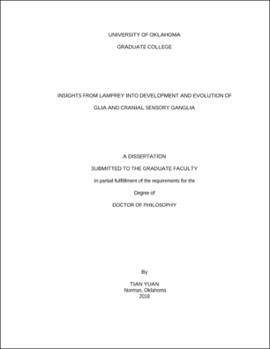| dc.description.abstract | During evolution, animal nervous systems have become increasingly complex. This complexity is based on the cumulative diversity of neural cells and the emergence of new nervous system structures. Among animals, vertebrates possess the most complex and specialized nervous system, which has evolved to contain diversified neural cell types that control organs with specialized functions. For the study of nervous system evolution, one outstanding question is how those novel cell types originated in the vertebrates. To address this question, this dissertation focuses on:
1) The evolution of one specific glial cell type in the vertebrate central nervous system (CNS)—oligodendrocytes, which form the myelin sheath in jawed vertebrate CNS;
2) The emergence of paired cranial sensory ganglia in the peripheral nervous system.
Myelin is a membrane protein that enables specialized cells to form an insulating layer around axons to speed up conduction along nerve cells. This protein and the cell types that form it (oligodendrocytes in the CNS and Schwann cells in PNS) are thought to be novel in jawed vertebrates. However, how these cell types evolved remains unclear. We asked whether the emergence of oligodendrocytes could only have occurred after the genetic “toolkit” required for this cell type appeared, or instead if the required genetic regulatory mechanism predates the evolution of the oligodendrocyte cell type itself. To address this question, I chose the basal jawless vertebrate—sea lamprey, since jawless vertebrates diverged from the jawed vertebrates prior to the evolution of oligodendrocytes. We used gene expression analyses coupled with functional perturbation using CRISPR/Cas9 mediated genome editing of sea lamprey embryos. My results indicate that the core genetic mechanism required for oligodendrocyte development is present in this jawless vertebrate, even though they lack this cell type, suggesting a core network regulating gliogenesis arose in the last common vertebrate ancestor. Sea lampreys appear to use this ancestral regulatory mechanism to control development of motor root glia. After the divergence of jawless and jawed vertebrates, other genes including myelinating proteins, were recruited onto this ancestral genetic scaffold and triggered the evolution of oligodendrocytes.
Next, I focused on the evolution of cranial ganglia in the peripheral nervous system (PNS) of vertebrates. Among jawed vertebrates, the sensory neurons present in cranial ganglia are derived from two different cell populations—neurogenic placodes and neural crest. However, likely mechanisms directing development of cranial ganglia in the vertebrate common ancestor remain unclear. To study the evolution of vertebrate cranial sensory ganglia, I determined functional cellular contributions to cranial ganglia development in lamprey. I used gene expression analysis, cell lineage tracing and genome editing functional analysis, to show that lamprey cranial sensory neurons are likely purely derived from placodes, while neural crest surround each ganglia and function to pattern the neurons properly into each ganglion. My results suggest that in jawed vertebrates, neural crest replaced sensory neurons in the proximal portion of cranial ganglia while placode-derived neurons occupy the distal portion. Overall, these studies have implications for understanding the primitive scenario of placode and neural crest functions during early cranial ganglia evolution, after they first appeared in the vertebrate common ancestor, and will lead to a better understanding of evolution of the vertebrate nervous system. | en_US |
